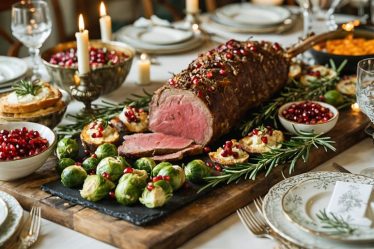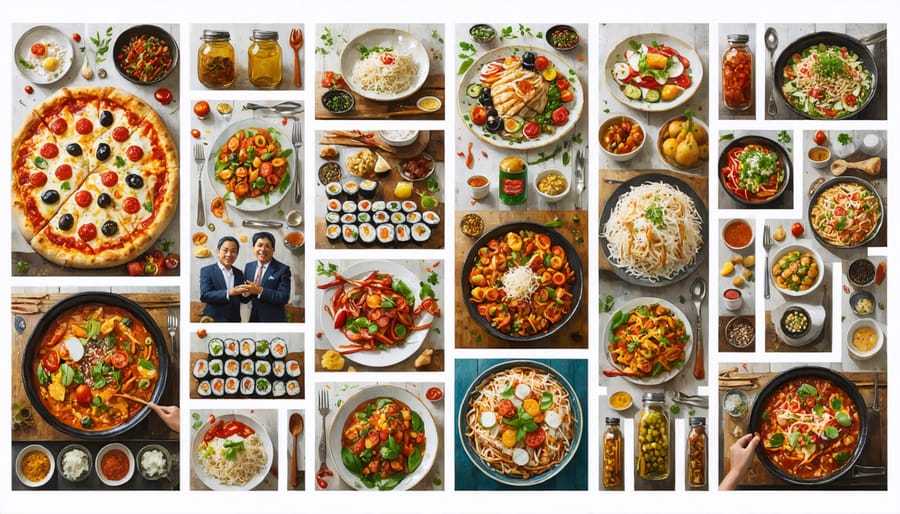
Picture a steaming bowl of your grandmother’s signature soup, its aroma instantly transporting you to childhood Sunday dinners. Food isn’t just sustenance – it’s the thread that weaves through the tapestry of human culture, connecting generations and telling stories of who we are and where we come from.
From the sacred rice offerings in Japanese Shinto temples to the breaking of bread in Mediterranean families, food serves as a powerful cultural ambassador, speaking a universal language that transcends borders and time. Each dish carries within it centuries of tradition, adaptation, and cultural evolution, reflecting the values, beliefs, and history of the people who create and share it.
Consider how Italian immigrants transformed New York’s culinary landscape with their pizza traditions, or how Korean kimchi represents not just a side dish but a testament to community cooperation and survival through harsh winters. These aren’t just meals – they’re edible narratives of human resilience and creativity.
As we gather around tables today, whether for a quick breakfast or an elaborate holiday feast, we’re participating in a timeless dance of cultural expression that began with our earliest ancestors. Every bite we take is seasoned with story, tradition, and belonging, making food perhaps humanity’s most delicious form of cultural preservation.
Family Traditions & Holiday Feasts
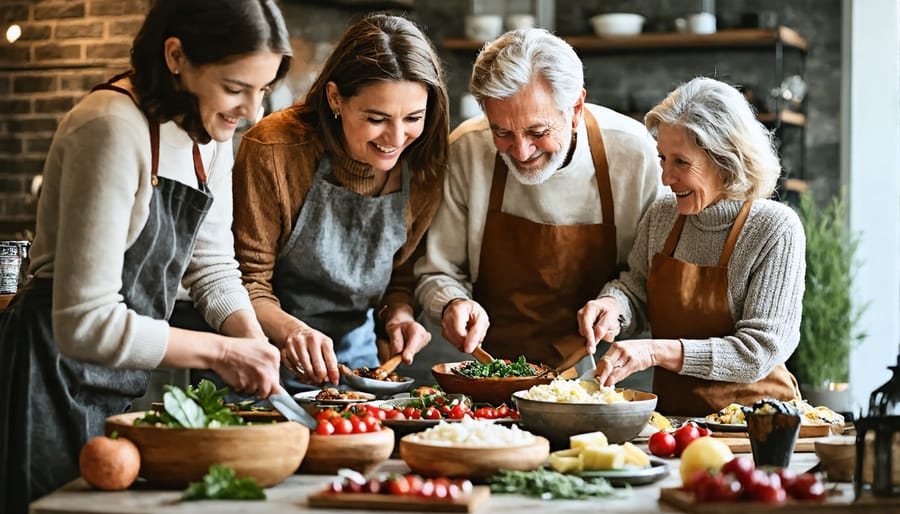
Passing Down Stories Through Recipes
Every time we open a well-worn recipe card or family cookbook, we’re not just accessing instructions for a dish – we’re unlocking generations of stories and memories. These cherished recipes, often splattered with sauce and marked with handwritten notes, serve as living documents of our family traditions and cultural heritage.
Consider the story behind Grandma’s secret dumpling technique, passed down through four generations, or the subtle adjustments made to a traditional pasta sauce recipe as families moved from Italy to new homes across the ocean. Each modification tells a tale of adaptation, survival, and love.
These culinary heirlooms carry more than measurements and cooking times; they hold the whispered secrets of holiday gatherings, Sunday dinners, and celebrations past. The marginalia – “Add extra garlic like Aunt Marie” or “Papa likes it spicier” – preserves personalities and preferences of loved ones, keeping their memory alive through the dishes they cherished.
Today, as families document recipes digitally and share them across social media, these stories find new ways to live on, connecting younger generations to their roots through the universal language of food.
Holiday Food Rituals Around the World
Every year, families around the globe gather to celebrate their most cherished holidays with special holiday dishes that carry deep cultural significance. In Japan, New Year’s celebration isn’t complete without ozoni, a warming soup containing mochi that symbolizes good fortune. Mexican families come together on Christmas Eve to prepare tamales, with recipes passed down through generations, each family adding their unique touch to this beloved tradition.
During Lunar New Year, Chinese households serve long noodles representing longevity and dumplings shaped like ancient gold ingots for prosperity. In Jewish culture, the Passover Seder plate tells the story of exodus through symbolic foods like bitter herbs and charoset. Indian Diwali celebrations light up with colorful mithai (sweets) and savory snacks shared between neighbors and loved ones.
These cherished food traditions do more than satisfy hunger – they strengthen family bonds, preserve cultural heritage, and create lasting memories. I still remember helping my grandmother prepare special dishes for our family gatherings, learning not just recipes but stories and wisdom that connected me to my roots.
Religious & Ceremonial Food Practices
Sacred Foods & Their Meanings
Food has always played a central role in religious practices and spiritual traditions across cultures. Take Passover, for example, where matzo (unleavened bread) symbolizes the Jewish people’s hasty exodus from Egypt. Similarly, in Christianity, bread and wine hold deep significance during communion, representing the body and blood of Christ.
In Hindu traditions, cows are considered sacred, and dairy products like ghee and milk are essential offerings in religious ceremonies. During Diwali, families prepare sweets like ladoo and barfi not just as treats, but as prasad (blessed food) to share with loved ones and deities.
For Muslims, dates hold special significance, particularly during Ramadan when they’re traditionally used to break the daily fast. The practice follows Prophet Muhammad’s example and carries both spiritual and practical benefits.
Buddhist cultures often incorporate mindful eating practices, and certain vegetables like garlic and onions are avoided by some practitioners during meditation periods. In Native American traditions, corn, beans, and squash – known as the “Three Sisters” – are considered sacred gifts from the Creator, representing the interconnectedness of all living things.
These sacred food traditions remind us that what we eat often carries meaning far beyond simple sustenance.
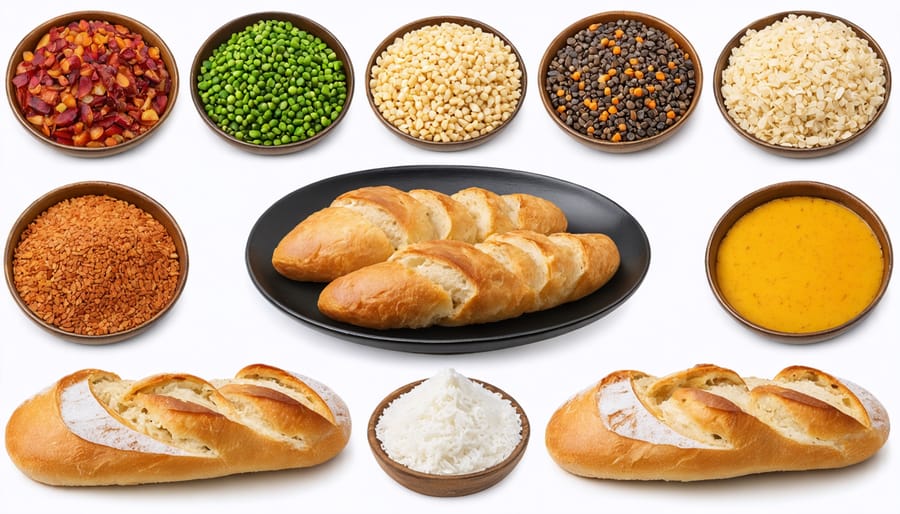
Fasting & Feasting Traditions
Food has long served as a powerful bridge between the physical and spiritual realms, with fasting and feasting playing central roles in religious and cultural celebrations worldwide. During Ramadan, Muslims fast from sunrise to sunset, making the evening iftar meal a cherished time for family gathering and gratitude. The anticipation of breaking the fast with dates and water, followed by traditional dishes, creates a profound sense of community and spiritual connection.
Similarly, Jewish traditions include fasting on Yom Kippur, followed by break-fast gatherings where families share comfort foods like bagels and lox. The contrast between periods of abstaining and celebrating through food adds deeper meaning to both experiences. In Christian traditions, Lent often involves giving up certain foods, while Easter celebrations feature symbolic foods like hot cross buns and lamb.
Hindu festivals beautifully demonstrate this duality, with many observances incorporating both fasting and elaborate feasts. During Karva Chauth, women fast from sunrise to moonrise for their husbands’ well-being, ending the day with special meals and sweets. These practices remind us that food isn’t just about sustenance – it’s a way to express devotion, practice mindfulness, and strengthen bonds within our faith communities.
Regional Identity Through Local Ingredients
Geography’s Influence on Cuisine
Have you ever noticed how coastal communities often feature seafood-heavy dishes, while mountain regions tend to embrace heartier, preserved foods? It’s no coincidence! The geography of a region plays a fascinating role in shaping local cuisine and food traditions.
Take Italy, for example. The sunny Mediterranean climate creates perfect conditions for growing tomatoes, olives, and herbs, which have become fundamental to Italian cooking. Meanwhile, in Iceland, the harsh climate and rocky terrain led to unique preservation methods like fermented shark and dried fish, making the most of available resources.
I remember visiting a small village in Thailand during the rainy season, where the locals showed me how their ancestors developed specific cooking techniques to work with monsoon-friendly ingredients. It was eye-opening to see how they’d adapted their entire food culture around seasonal flooding patterns!
Climate doesn’t just influence what grows locally – it also affects cooking methods. Desert communities often developed slow-cooking techniques to conserve fuel and water, while tropical regions embrace quick cooking to avoid heating their homes in already warm weather.
These geographical influences create the beautiful diversity we see in global cuisine today, each region telling its own unique food story through the landscape that shaped it.
Signature Dishes That Define Regions
Every corner of the world tells its story through signature dishes that have become culinary ambassadors of their regional cuisines. In Italy’s Naples, pizza Margherita emerged as a tribute to Queen Margherita, featuring colors of the Italian flag through basil, mozzarella, and tomatoes. The paella of Valencia, Spain, reflects the region’s agricultural heritage, combining saffron-tinted rice with local seafood and vegetables.
Moving east, Japan’s sushi originated as a preservation method in the 8th century, evolving into the artful dishes we know today. In India, the beloved biryani varies dramatically by region – Hyderabad’s version features tender lamb and aromatic spices, while Kolkata’s includes potatoes and eggs, telling tales of colonial influence.
Closer to home, New Orleans’ gumbo represents a beautiful fusion of African, French, and Native American cultures, while Quebec’s poutine emerged from humble beginnings to become Canada’s comfort food icon. Each dish carries not just flavors but generations of stories, celebrations, and cultural pride.
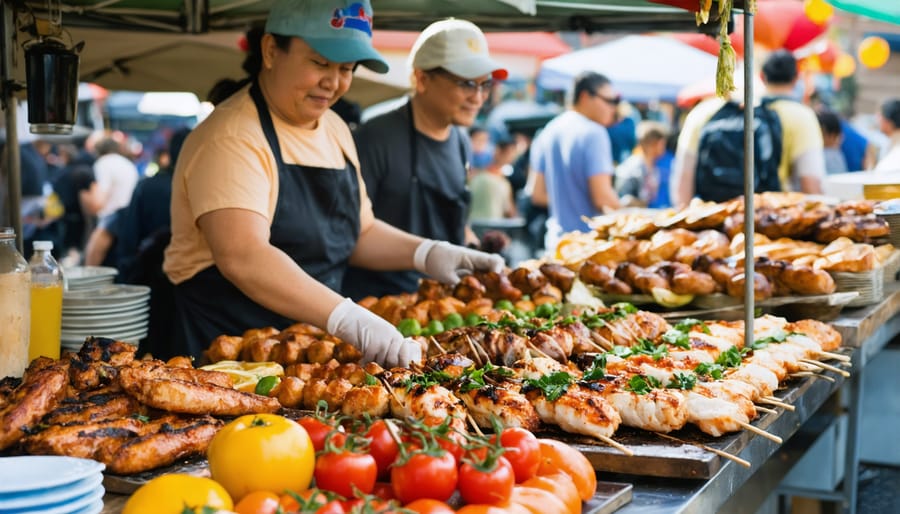
Social Bonding & Community Gatherings
Communal Cooking Traditions
Picture a bustling Italian kitchen where three generations of women gather to make fresh pasta, their hands working in perfect rhythm as they share stories and laughter. This scene plays out in countless homes across cultures, where communal cooking serves as the heartbeat of family and community connections.
In Mexican households, tamale-making parties called tamaladas bring extended families together, often during holiday seasons. Everyone has a role, from spreading masa on corn husks to preparing fillings, creating an assembly line of love and tradition that results in dozens of tamales and countless precious memories.
Similarly, in many Asian cultures, the tradition of making dumplings or mooncakes becomes a family affair, with relatives gathering around the table, each person perfecting their own folding technique while catching up on family news. These gatherings often span hours, transforming what could be a solitary task into a cherished social event.
Modern interpretations of communal cooking continue this tradition through neighborhood potlucks, cooking clubs, and community kitchen initiatives, proving that food’s power to unite people remains as strong as ever.
Celebration Foods & Their Significance
From the joyful chaos of wedding feasts to the warmth of holiday gatherings, celebration foods are the heart of cultural festivities worldwide. Take the Mexican quinceañera, where the towering tres leches cake symbolizes a young woman’s transition to adulthood, adorned with meaningful colors and decorations chosen by her family.
In Chinese culture, the humble dumpling transforms into a symbol of prosperity during Lunar New Year celebrations, with families gathering to wrap these precious parcels while sharing stories and hopes for the coming year. The round shape represents wholeness and unity, while the filling signifies abundance.
Indian weddings showcase elaborate spreads of traditional delicacies, where each dish carries its own significance. The serving of sweet treats at the beginning of the meal, for instance, represents the wish for a sweet life ahead for the newlyweds.
Even in everyday celebrations, like birthdays in American culture, the ritual of blowing out candles on a cake has evolved into a universal symbol of marking another year of life. These special dishes do more than satisfy hunger – they create memories, strengthen bonds, and carry forward cherished traditions from one generation to the next.
Modern Food Culture & Global Influence
Fusion Cuisine & Cultural Exchange
In today’s interconnected world, the lines between traditional cuisines are beautifully blurring, creating exciting new flavor combinations that tell stories of cultural exchange and innovation. I remember discovering Korean-Mexican fusion tacos at a local food truck – the perfect marriage of kimchi and carnitas that somehow felt both revolutionary and familiar.
These culinary crossovers aren’t just about creating Instagram-worthy dishes; they represent the evolution of our modern food choices and cultural identities. Think of California rolls, which introduced many Americans to sushi through a comfortable, avocado-filled adaptation. Or the beloved butter chicken pizza, a testament to how Indian flavors have seamlessly integrated into Western comfort food.
What’s particularly fascinating is how these fusion dishes often become cultural ambassadors in their own right. Japanese ramen, for instance, evolved from Chinese wheat noodles but has become distinctly Japanese, and now inspires chefs worldwide to create their own interpretations. These culinary innovations reflect our increasingly connected world, where traditions aren’t just preserved but thoughtfully reimagined, creating new food traditions that celebrate both heritage and adaptation.
Preserving Cultural Identity in Modern Times
In today’s fast-paced world, many families are finding creative ways to keep their cultural food traditions alive while adapting to modern lifestyles. Take Maria, a working mother who hosts weekly Sunday cooking sessions with her children, teaching them to make her grandmother’s tamales while sharing stories about their Mexican heritage. These moments become precious bridges between generations, preserving family history through taste and technique.
Communities are also embracing technology to maintain their food traditions. Social media groups dedicated to specific cuisines help people share recipes, tips, and modifications for traditional dishes using readily available ingredients. Food festivals and cultural celebrations have evolved to include fusion elements while maintaining authentic core recipes, showing how tradition can coexist with innovation.
Many families are creating “hybrid kitchens” where traditional cooking methods meet modern conveniences. For instance, using slow cookers to simulate the long-simmering processes of traditional stews, or incorporating healthier ingredients while keeping traditional spice blends and cooking techniques intact. Local markets and specialty stores are responding to this trend by stocking both traditional ingredients and modern alternatives, making it easier for people to maintain their cultural food practices in contemporary settings.
As we’ve explored throughout this article, food is so much more than just sustenance – it’s a living, breathing expression of who we are and where we come from. Every family recipe passed down through generations, every holiday feast, and even our daily cooking habits tell a story about our cultural identity and heritage.
Think about your own favorite childhood dishes or the meals that make you feel most at home. These aren’t just recipes; they’re threads in the tapestry of your personal history and cultural background. Whether it’s your grandmother’s secret sauce recipe or the special bread your family makes for celebrations, these food traditions help define who you are and connect you to your roots.
I encourage you to take some time to explore your own food heritage. Talk to older family members about traditional recipes, document cooking techniques that have been passed down, or even organize a heritage food gathering with friends to share dishes from different cultural backgrounds. You might be surprised by how much you learn about yourself and others through these culinary conversations.
Remember, embracing and sharing our food traditions isn’t just about preserving the past – it’s about building bridges between cultures and creating new memories for future generations. Every time we cook a traditional dish or share a meal with loved ones, we’re keeping our cultural heritage alive and adding our own chapter to this ongoing story.
Let’s celebrate the beautiful way food connects us all, while honoring the unique flavors and traditions that make each culture special.


